9 Finding Libraries, Folders, and Documents
This chapter details the steps to browse and search for documents. It covers the following topics:
9.1 About Finding Libraries, Folders, and Documents
Documents are stored in Oracle WebCenter Content and organized into libraries. There are two types of libraries:
-
System Libraries, created and managed by Oracle WebCenter Content to organize documents that are in a system process, such as checked-out or expired documents. Documents cannot be uploaded to a system library.
-
Enterprise Libraries, created by individuals to provide flexible security and comprehensive document management used by an entire organization.
Each library can have folders and each folder can have subfolders. Just like you browse to documents on your computer using folders, you can also browse to documents in the libraries of Oracle WebCenter Content using folders. Folders provide a familiar way of navigating. However, folders in Oracle WebCenter Content are virtual, meaning that they are collections of like metadata that tell Oracle WebCenter Content how to filter documents when you browse. Because of this, you can use a combination of searching and browsing to quickly filter your results to find the documents you need.
9.2 Using the Find Documents Page
The Find Documents page is displayed when you first log in to Oracle WebCenter Content. The main sections of the Find Documents page are:
-
Side bar
-
Search box in the banner area
-
Folder search box and folder listing in the side bar (active when browsing and a library has been selected)
-
Results list
When you log in to Oracle WebCenter Content the first time, the Search link is active in the side bar and the latest released revision of all documents in Oracle WebCenter Content to which you have access are displayed in the results list. In this view, all documents are displayed in a single flat list regardless of what library or folder they may be in. You can review the results in the content area or filter the results using the search box above the content area. For information about using the search box,
See Searching Using the Banner Search Box.
Click Browse in the side bar to navigate through libraries and folders much like you browse folders on your local computer. Documents and folders in the library or folder you are browsing display in the results list, and the folder hierarchy you are browsing is displayed in the side bar. When browsing, the search box in the banner searches only the names of documents within the library or folder you are browsing, and a secondary search field is available above the folder hierarchy to use when searching for folders.
You can personalize this page to display all documents, all libraries, or your favorites the next time you log in.
9.3 Browsing Using the Side Bar
Clicking Browse in the side bar allows you to browse documents, and all libraries to which you have access are displayed in the results list. The type of library is noted by the icon used. For additional information on browsing, see Browsing.
9.3.2 How do I browse through favorites?
Click Favorites in the side bar to display all items you have specified as favorites. Unlike browsing libraries, a Favorites results list can display folders, libraries, saved searches, and any documents set as a favorite. Note that if you set a shortcut as a favorite, the target item is displayed when browsing favorites.
9.3.3 How do I browse through folders in the side bar?
Folders, subfolders, and saved searches are displayed in the side bar once a library has been opened from the results list, or by searching using the search box at the top of the page (see Searching Using the Banner Search Box). To browse through a folder:
9.3.4 Browsing versus searching
You can find documents by browsing through libraries and folders, by searching for key words or phrases in document text and metadata, or a combination of both. The results displayed in the results list change depending on whether you are browsing or searching. Table 9-1 describes how the results differ between browsing content and searching metadata. For information about the differences in search behavior, see Searching and browsing.
Table 9-1 Results Differences Between Browsing Documents and Searching Metadata
| Option | Description |
|---|---|
|
Browse |
When browsing:
|
|
Search |
When searching metadata and full-text:
|
9.3.5 How do I switch between searching and browsing?
When you log in to Oracle WebCenter Content the first time, you are outside the context of any library or folder. Use the search box to search metadata and full-text, if enabled, or click Browse in the side bar to navigate through libraries and folders to find the content you need. Note that you can personalize this page to display all documents, all libraries, or your favorites the next time you log in.
If you want to search within an entire library or folder easily, you can browse to the library or folder you want to search, then search within the library or folder by selecting the Search <Library/Folder> and Subfolders option in the library or folder drop-down menu (see Figure 9-1). This enables you to search all the released documents in the library or folder you are browsing.
If you want to switch back to browsing after searching but remain in the library or folder you are in, click the title of the library or folder tab in the search box or select the Return to Browsing <Library/Folder> option from the search title drop-down menu (see Figure 9-2).
Figure 9-2 Switching from Searching Back to Browsing

9.4 Searching Using the Banner Search Box
Searching for documents, folders, and libraries is done using the search box in the banner at the top of the page. As you enter text in the search box, it expands to provide suggestions based on close matches to what you enter. It does not only show exact matches. This means that you may see results in the expanded search box that won't be displayed in a results list when you execute the search by pressing Enter or clicking the search icon ![]() next to the search box. For example, entering Hon in the search box may display a suggestion for the folder Honna as well as On Hold, both of which are close matches. However, once you execute the search, neither are displayed in the results list, because they do not exactly match the entered text of Hon.
next to the search box. For example, entering Hon in the search box may display a suggestion for the folder Honna as well as On Hold, both of which are close matches. However, once you execute the search, neither are displayed in the results list, because they do not exactly match the entered text of Hon.
Note:
If the Auto Suggest feature is disabled, the Search Box doesn’t automatically prompt results when you enter a search term. The categories in the pop-up window—Documents, Libraries, and Folders—are displayed with no results. Contact your system administrator to enable the Auto Suggest feature.Figure 9-3 Expanded Search Box
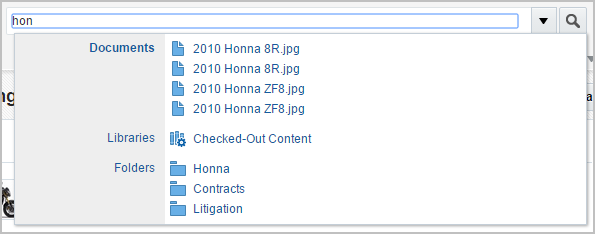
To search using the search box in the banner area:
9.4.1 Understanding text entry
When searching, text entered into the search box creates a custom filter based on the text you enter. When you press Enter, the text in the search box is compared to indexed metadata such as document, folder, and library titles as well as the full-text of each document if Oracle WebCenter Content is configured to index full-text.
When you begin entering text into the search box before pressing Enter, the box expands to display a list of possible result options organized into sections by Documents, Folders, and Libraries. For example, entering HR would show documents named HR Vacation Policy and HR Employees, folders named HR Forms and HR Policies, and a library named HR.
Continuing to enter text immediately filters the results. In this example, if you continued typing HR P, the search box result options would change to show only the folder named HR Policies. Note that the document named HR Vacation Policy would not be displayed, even though it has both HR and P in the title. The entered text must be sequential in the returned result.
The entered text does not have to be at the beginning of the name of the document, folder, or library. It can be anywhere in the title and is not case sensitive. For example, entering POL would display result options for the HR Vacation Policy document and the HR Policies folder, even though the names do not begin with what was entered.
9.4.1.1 How do I search metadata when browsing?
If you browse to a particular library or folder before you search with the banner search box, your search is confined to the titles of the documents or folders in the library or folder you are browsing. To search the folder or library using metadata, you must select the Search <Library/Folder> and Subfolders option in the library or folder drop-down menu (see Browsing versus searching).
9.4.2 How do I use predefined filters to refine results?
Predefined filters are created by a system administrator as a way of refining what documents are included in a search by selecting to search only documents that meet the specified criteria, such as a specific content type or within a specific security group. The Favorites link in the side bar is a predefined filter. You can display additional predefined filters by clicking the Filter icon next to the search box. One or more filters can be selected and are displayed as tags in the search box. Predefined filters can be used along with text entered into the search box to better refine your search.
Note:
When browsing, predefined filters for documents are limited to documents authored, favorited, followed, or checked out by you. Predefined filters when browsing libraries are limited to libraries created, favorited, and followed by you, enterprise and system libraries.
To use filters when searching:
- Click the Filter icon next to the search box to display and select filter options to refine the results. The applied filter is displayed as a tag in the search box and the results list refreshes to display documents meeting the filter criteria.
- Enter text into the search box to refine your search within the context of the applied filter.
Figure 9-4 Search Box and Filter Menu

9.4.3 How do I clear filters?
Once you apply a filter, the filter tag is displayed in the search box and remains active until you clear it. To clear a filter, click the X in the filter tag to close it. If you want to quickly clear all tags, click the Search link in the side bar. Clicking the Search link takes you to the top-level of Oracle WebCenter Content, outside of any library context.
9.4.4 Supported wildcards
The following wildcard behavior is supported in the search box:
Table 9-2
| Wildcard | Behavior |
|---|---|
|
* |
Enter to represent an infinite number of unknown characters |
|
? |
Enter to represent a single unknown character. Enter multiple times to represent a specific number of unknown characters. |
Note:
To search for an asterisk (*) or a question mark (?) without treating it as wildcard, you must escape the wildcard character by putting a backslash (\) before it; for example: here\*
9.5 Searching for Folders
You can search for folders using either the search box at the top of the Find Documents page, or by browsing to a library or folder first, then using the search box in the side bar.
9.5.1 How do I search for folders using the search box?
To search for a folder using the search box at the top of the Find Documents page:
- Enter the folder name or part of the folder name in the search box. The search box expands to show a list of suggestions.
- Select a folder from the list of suggestions, or click Folders to display a result list of folders from which to choose.
Note:
Selecting Folders applies the Folders filter. The Folders filter allows you to search for folders across all libraries.
Figure 9-5 Search Box with Folder Options Displayed

9.5.2 How do I search for folders using the side bar?
Once you browse to a library, folders within the library are listed in the side bar. There you can browse the folder hierarchy or use the folder search box above the hierarchy to find a specific folder in the library. The folder search box always searches in the context of whatever library or folder you are in, as opposed to the search box in the banner area, which can search across multiple libraries.
To search for a folder using the search box above the folder list in the side bar:
- Navigate to the library or folder you want to search. A folder hierarchy is displayed in the side bar.
- Enter the folder name or part of the folder name in the folder search box and press Enter or click the search icon next to the box. A list of close matches is displayed.
Note:
-
The search box returns suggestions based on close matches to what you enter. It does not only show exact matches. For example, entering Hon in the search box may display a suggestion for the folder Honna as well as On Hold once you execute the search.
-
If the Auto Suggest feature is disabled, the Folder Search Box isn’t displayed in the side bar. Contact your system administrator to enable this feature.
Figure 9-6 Folder Search Box and Folder Hierarchy
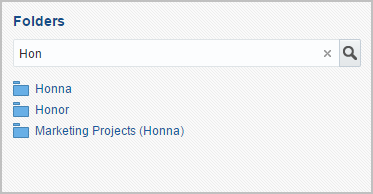
9.6 Using System Libraries to Find Documents in a Process State
System libraries can be used to quickly find documents that are being processed by Oracle WebCenter Content but not yet released. For example, documents that are checked out, expired, or being converted into different formats. For details on using system libraries to find unreleased content, see Using System Libraries to Find Content.
9.7 Using Advanced Search Capabilities
Advanced search forms provide more flexibility for entering search criteria. To use an advanced search form, you select it from the search box menu. Advanced search forms are only available when searching. They include the standard form listing all metadata fields, or profile forms listing only those metadata fields used in a specific profile set up by your system administrator. Using an advanced search form you can search for metadata, full-text if it is configured, or a combination of both on all available fields.
Figure 9-7 Search Box Menu Showing Advanced Search Form Links

9.7.1 What is a metadata search?
With the advanced search form, you can search for document properties such as security group, author, title, or other defining criteria.
Note:
Searches built using an advanced search form separate the metadata fields with the <AND> operator, meaning that each value entered into each field must be met in order to find a document. For example, if you enter January into the Title field and presentation into the Type field, then a search finds content only if it has a presentation type and has January in the title.
9.7.2 What is a full-text search?
You can also search for text used in a document if your system administrator has configured Oracle WebCenter Content to index full-text. If configured to search full-text, the additional search field Full-Text Search is added to the standard advanced search form and may be available in profile searches.
9.7.3 How do I use an advanced search form?
To search using an advanced search form:
- When searching, select a form from the Search Forms section of the search box menu.
- Enter values in the fields you want to search and click OK. For example, you can search for a document title, security group, or if configured for full-text search, then for text in a document. For information on using wildcards to help search, see Supported wildcards. For information on how to use search operators, see Metadata search operators for a database metadata search.
9.8 Saving Searches
Some search criteria can be saved and executed quickly using a saved search. Saved searches give you the experience of browsing through a file system while in reality searching for content using metadata. For example, a saved search can be created titled 1st Quarter Documents that when clicked displays all documents checked in during the months of January through March. The contents change every day without people having to upload documents to a specific folder, because clicking the saved search folder tells Oracle WebCenter Content to find all documents uploaded in January through March and display them in a list.
Some ways of searching cannot be saved. If you are browsing, the Create New Saved Search option is not available in the library or folder drop-down menu. To save the search, you would first have to select the Search <Library/Folder> and Subfolders option from the library or folder drop-down menu. For information on how to change between searching and browsing, see Browsing versus searching.
To save a search:
- Search for documents by browsing, using the banner search box, or using a search form.
- When the results are displayed, select the Create New Saved Search option from the search title drop-down menu. If the Create New Saved Search option is not available in the menu, click the Search <Library/Folder> and Subfolders option from the library or folder drop-down menu. For more information, see How do I switch between searching and browsing?.
- In the Save Search screen, enter a name for the search and an optional description.
- Search for a folder location where you want the search to be saved. You can search for a folder in all libraries or narrow your search by library.
- Click Save. The search is saved to the location you specified.
Figure 9-8 Saving a Search
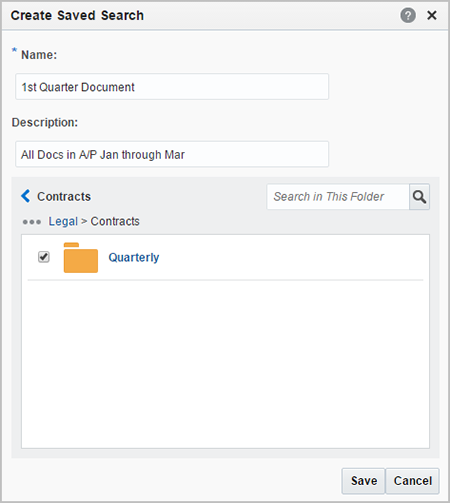
Note:
If the Auto Suggest feature is disabled, the Folder or Library Search Box isn’t displayed within the Create Saved Search dialog. Contact your system administrator to enable this feature.9.8.1 How do I use a saved search?
Saved searches are displayed in the folder hierarchy in the side bar as well as in the results list. To use a saved search, navigate to the folder in which the search is saved, and click on the saved search to view the search results.
9.8.2 How do I modify saved search properties and criteria?
If you have the permissions to do so, you can modify the properties of a saved search, such as title and sharing options, in the same way that you modify library and folder properties. For more information on folder types and modifying library and folder properties, see Viewing and Editing Document Library Properties.
To modify a saved search, navigate to the folder in which the search is saved and do the following:
- Run the saved search.
- Change the search criteria.
- Select the Update Saved Search <Name> option from the saved search drop-down menu.
Figure 9-9 Update Saved Search Option in Save Search Menu
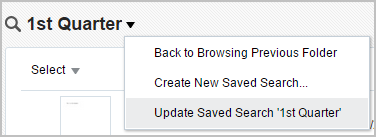
9.9 Working with the Results List
When searching or browsing, results are displayed in the content area as a results list. All results lists, except the Rendition Clipboard results list, can be viewed as lists, thumbnails, or tables as detailed in Results view. Some results lists can be sorted. There are six types of results:
-
Favorites results are displayed with the most recently marked items listed first and cannot be sorted.
-
Library results are displayed when you click Browse in the side bar. Library results cannot be sorted.
-
Folders results are similar to library results and cannot be sorted. Folder results differ from library results in that their contextual menus have options available to folders but not libraries.
-
Documents and Folders results can be sorted (see section How do I sort results?.) Document results can also be filtered when searching to show documents in all subfolders, or when browsing to show documents and folders only at the top level of the selected library or folder, as well as unreleased revisions and document shortcuts. For detailed information on changing between searching and browsing, see Browsing versus searching.
-
Rendition Clipboard results are displayed when you click the Rendition Clipboard icon (
 ) in the banner area. You cannot sort or change the view of this results list.
) in the banner area. You cannot sort or change the view of this results list.
-
Trash results are displayed when you click Trash in the side bar. Trash results can be sorted.
In a results list, browsing a library or folder displays the latest revision of all documents at the top level of the library or folder as well as any subfolders. Browsing does not display documents in subfolders within the library. To display documents in all folders and subfolders of a library or folder, browse to the folder then select the Search <Folder> and Subfolders option in the folder drop-down menu.
To open a library, click the library thumbnail image, or the library title if in the list view. To open a document, click the document title in the results view. Opening the document from a results list displays the document in the View Documents page.
9.9.1 Results view
In a results list, the name of each item and its corresponding icon are displayed. Some results lists also provide the option to set an item as a favorite. In such results lists, the Favorite/Unfavorite icon is displayed next to the item. There is also a check box is present next to each item in a results list (except for the Favorites results list). Selecting the check box enables the results toolbar (see Modifying Items Using the Results Toolbar).
You can change how a results list is displayed using the View menu. To change the results view:
9.9.1.1 When should a results list be refreshed?
Due to the need to index documents as they or their metadata are modified, changes to the results list when in searching are not displayed until the search index is refreshed in these cases:
-
When a document is uploaded
-
When a new revision is uploaded
-
When a document name is changed
-
When a document is moved to a different library or folder
-
When a document is deleted
-
When a document is removed from a library
9.9.2 How do I sort results?
Documents, folder, and trash results lists can be sorted, but library, favorites, and renditions clipboard results lists cannot. To sort a results list, select the sort option from the Sort By menu. The sort options are:
-
Release Date
-
Name
Options can be sorted in Ascending or Descending order and folders are always displayed before documents.
9.9.3 How do I change the number of items displayed per page?
You can specify the number of items displayed in a results list by using the Items Per Page menu in the content area of a results list. Libraries items per page and document items per page can be specified individually. The chosen option remains as the default view until it is changed.
9.9.4 How do I pin a view?
Click the Pin This View Icon ![]() to save a current view. You are prompted to enter a name for the saved view, and the name appears in the banner with the oldest pin nearest to the icon.
to save a current view. You are prompted to enter a name for the saved view, and the name appears in the banner with the oldest pin nearest to the icon.
Click the name of the view in the banner to return to it. The saved view includes any search and filter criteria, any library and folder selections, and the current sort and view selections.
9.9.5 How do I set a favorite?
To mark a document or library as a favorite, click the Favorite icon next to the item in a results view. Click again to clear the favorite.
Note:
Marking a shortcut as a favorite also sets the target library, folder, or document as a favorite. Unmarking either the shortcut or target item clears both the shortcut and target item.
To mark a folder as a favorite, do one of the following:
-
Navigate to the folder you want to mark so that it is listed in the side bar, then right-click the folder and select Favorite. Repeat the process to clear the folder.
-
Begin searching for the folder you want using the banner search box and select Folders from the suggestion list in the expanded search box. Locate the folder in the results list and click the Favorite icon next to the folder in the content area.
Note:
You cannot mark a cloud folder as a favorite.
Figure 9-10 Filtering Results to List Folders
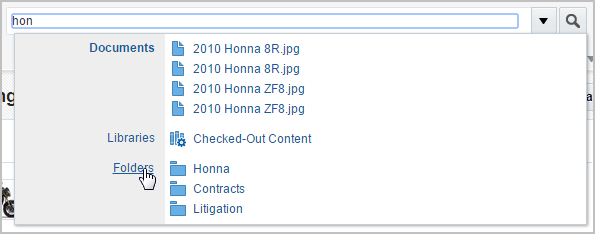
Figure 9-11 Folder Results List with Favorite Marked
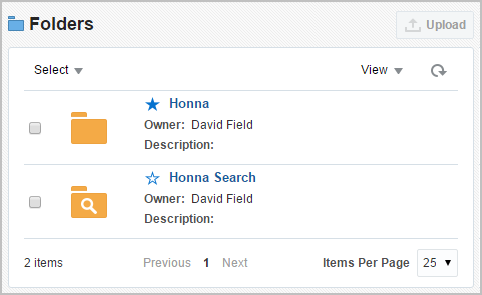
9.9.6 How do I follow items?
You can follow a library, folder, or document and be notified when documents are added and modified. To follow an item, do one of the following:
-
Select the item on a results list and choose Follow from the More menu in the results toolbar.
-
Right-click an item in a results list or in the Folders list of the side bar and select Follow from the contextual menu.
Note:
Followed items are noted with a check mark next to Follow in the More or contextual menus. Clear the check mark to no longer follow an item.
To quickly display a list of all documents you are following:
-
Click Search in the side bar to clear all filters from the search box.
-
Select Followed by you from the filter menu in the document list of the search box.
Note:
When using the Followed by you filter when searching, libraries that you are following are not displayed in the results list. If browsing libraries, libraries are displayed when using the Followed by you filter.
If you want to limit the list of documents you are following to those in a specific library or folder:
- Browse to the library or folder.
- Select Followed by you from the filter menu in the document list of the search box.
9.10 Modifying Items Using the Results Toolbar
Selecting an item or items in a results list enables the results toolbar. Note that the available options in the toolbar depend on your permissions to the selected item or items. The following table lists the actions available for items in a document, folder or library results list. For actions available in renditions clipboard and trash results lists, see How do I use the renditions clipboard? and Working with Items in Trash respectively.
| Icon | Option | Description |
|---|---|---|
|
|
Check In New Revision |
Checks out the selected item and prompts you to check in a new revision. This option is not available if multiple items are selected. |
|
|
Get Link |
Displays links to view the document properties page and to the native file of the latest released revision or optionally the specific revision in the result list. This option is not available if multiple items are selected. |
|
|
Move |
Prompts you to move the selected item or items. Available when single or multiple items are selected. |
|
|
Copy |
Prompts you to copy the selected item or items. Available when single or multiple items are selected. |
|
|
Delete |
Prompts you to delete the selected item or items. Available when single or multiple items are selected and you have rights to delete the items. |
|
|
Properties |
Displays the Library or Folder Properties page. |
|
More |
Has the following possible options (note that some may be unavailable depending on your permissions): |
Lists options for modifying documents. This option is not available if multiple items are selected. |
|
Propagate (folder only) |
Displays the Propagate page. |
|
|
Check Out/Cancel Check Out |
Checks out the selected item. After checking out an item, you must either check in a new revision or undo the check-out before the item can be revised again. |
|
|
Download |
Prompts you to download the selected item. |
|
|
Launch Web Rendition |
Displays the web rendition of the selected item. |
|
|
Launch Dynamic Conversion |
Displays the HTML conversion of the selected item. |
|
|
Add to Rendition Clipboard |
Prompts you to choose what renditions of the selected item you want to add to the rendition clipboard. The rendition clipboard stores specific renditions of specific document revisions for quick access. For example, you can save a web-viewable rendition of the first revision of a document as well as a native version of the current revision so that you can quickly compare them. Click the rendition clipboard icon |
|
|
Follow |
Starts tracking of the selected item so you can follow it. |
|
|
Create a Shortcut |
Prompts you to create a shortcut of the selected item. |
|
|
Rename |
Prompts you to rename the selected item. Renaming a cloud folder results in a rename of the corresponding Oracle Content Management Cloud Service folder. |
|
|
File/Unfile Document |
Allows you to file the selected unfiled document in a library or folder, or remove the selected filed document from a library. |
|
|
Upload Similar document |
Prompts you to upload a similar item. Selecting this option prepopulates the metadata values of the Document Upload form with those of the selected document. |
|
|
Properties |
Opens the Document Properties page. |
